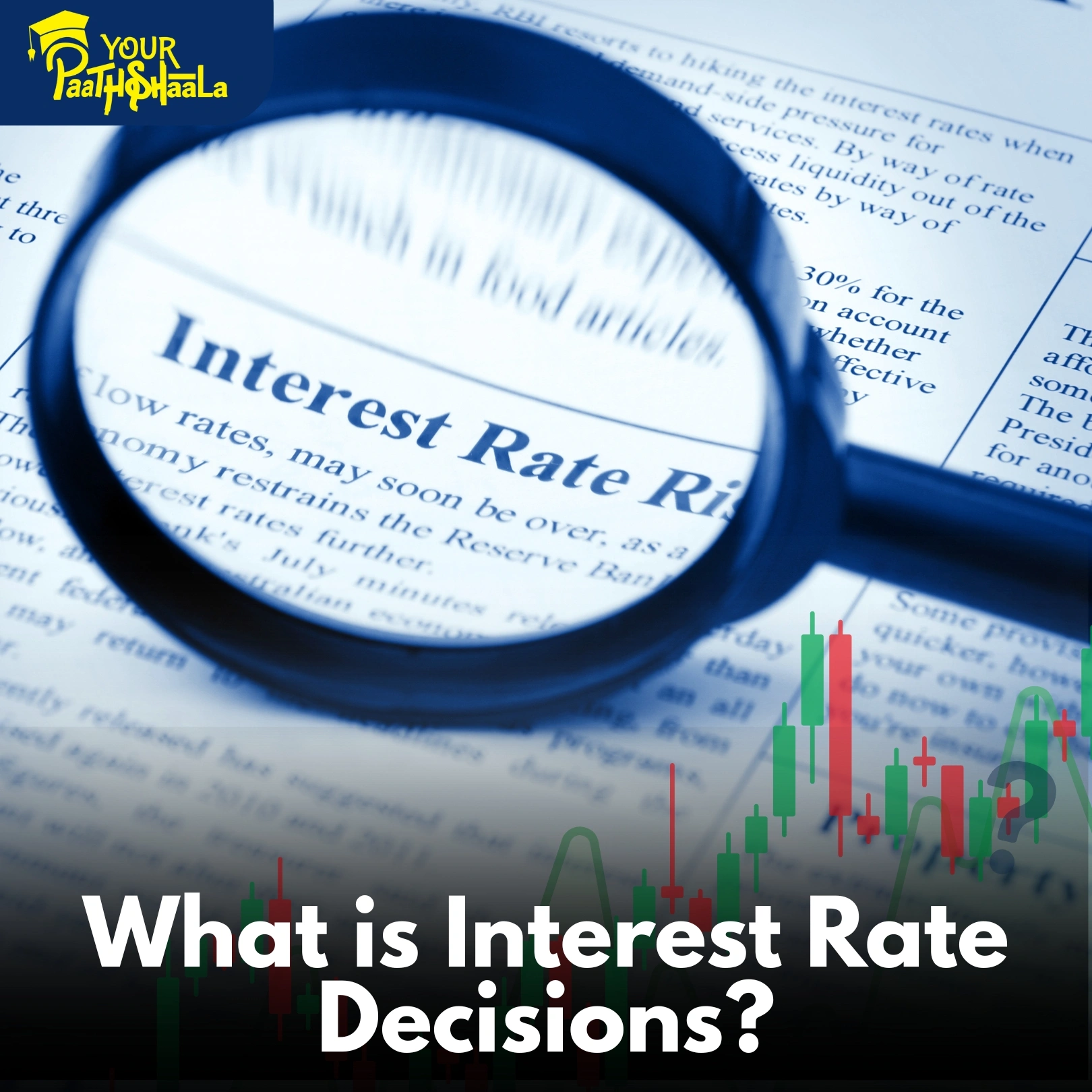How Interest Rate Decisions Impact Markets: A Complete Guide for Traders
Interest rate decisions are among the most powerful levers central banks use to steer economies and influence financial markets. Whether you are a beginner or an experienced trader, understanding how interest rate changes affect stocks, bonds, and overall market sentiment is essential for making informed investment decisions.
This guide will explain the mechanics of interest rate decisions, their impact on different asset classes, and why monitoring central bank policies is crucial for successful trading.
What Are Interest Rates and Who Sets Them?
Interest rates represent the cost of borrowing money. They are set by central banks—such as the Federal Reserve in the United States, the European Central Bank (ECB) in Europe, and the Reserve Bank of India (RBI) in India—and serve as a benchmark for all other lending rates in the economy.
Central banks adjust interest rates to achieve key economic objectives, including controlling inflation, supporting employment, and fostering economic growth356.
How Do Interest Rate Changes Affect the Stock Market?
The Relationship Between Interest Rates and Stock Prices
When central banks raise interest rates, borrowing becomes more expensive for both businesses and consumers. This can lead to:
Lower corporate profits: Companies face higher costs for loans and expansion, which can squeeze margins and reduce earnings.
Reduced consumer spending: Higher loan rates discourage big purchases like homes and cars, slowing economic activity.
Lower stock valuations: Future earnings are discounted at a higher rate, making stocks less attractive compared to risk-free assets like government bonds136.
As a result, stock prices often decline when interest rates rise. Conversely, when central banks cut rates, borrowing becomes cheaper, stimulating business investment and consumer spending, which can boost stock prices136.
Real-World Examples
COVID-19 Pandemic (2020): The Federal Reserve slashed interest rates to near zero to support the economy, leading to a rapid recovery in stock markets.
2022 Rate Hikes: As inflation surged, the Fed aggressively raised rates, causing stock prices to fall and market volatility to increase.
September 2024 Rate Cut: The Fed’s decision to cut rates for the first time in over four years signaled a shift toward supporting economic growth, boosting market sentiment13.
How Do Interest Rates Affect Bonds and Fixed-Income Securities?
Bond Prices and Interest Rates: An Inverse Relationship
Bond prices move in the opposite direction of interest rates. When interest rates rise:
Existing bonds with lower coupon rates become less attractive compared to new bonds issued at higher rates.
Bond prices fall to make their yields competitive with new issues26.
Long-term bonds are more sensitive to rate changes than short-term bonds because their cash flows are discounted over a longer period2.
Conversely, when interest rates fall, existing bonds with higher coupons become more valuable, and bond prices rise.
Impact on Fixed-Income Investors
Rising rates: Investors may prefer shorter-term bonds or alternative assets to reduce risk.
Falling rates: Long-term bonds can offer capital gains as their prices appreciate26.
Why Is Monitoring Central Bank Policies Important for Traders?
1. Anticipating Market Movements
Central bank announcements about interest rates can cause immediate and significant market reactions. Traders who anticipate these moves can position themselves to profit from expected price changes36.
2. Managing Risk
Unexpected rate changes can lead to sharp volatility. By staying informed about central bank policies and market expectations, traders can adjust their portfolios to manage risk36.
3. Adjusting Investment Strategies
Interest rate trends influence which asset classes are most attractive. For example, when rates are rising, traders may shift toward defensive stocks or short-term bonds. When rates are falling, growth stocks and long-term bonds may become more appealing126.
The Global Impact of Central Bank Decisions
Major Central Banks and Their Influence
Federal Reserve (U.S.): The Fed’s decisions have a global impact because the U.S. dollar is the world’s primary reserve currency. Rate hikes can attract foreign capital, strengthening the dollar and affecting emerging markets35.
European Central Bank (ECB): ECB policies influence the euro and European markets, with ripple effects across global trade and investments45.
Bank of Japan (BoJ): The BoJ’s actions affect the yen and Japanese markets, with implications for global investors5.
Currency Markets
Interest rate changes also impact currency values. Higher rates tend to attract foreign investors seeking higher returns, leading to currency appreciation. Lower rates can weaken a currency as investors look elsewhere for yield45.
Practical Tips for Traders: Navigating Interest Rate Changes
1. Stay Informed
Follow central bank announcements: Pay attention to scheduled meetings, press conferences, and policy statements.
Monitor economic indicators: Watch for inflation, employment, and GDP data, as these influence central bank decisions36.
2. Understand Market Expectations
Anticipate policy shifts: Markets often price in expected rate changes. Surprises can cause sharp price movements and increased volatility36.
Watch for forward guidance: Central banks often signal future policy intentions, which can help traders adjust their strategies56.
3. Diversify Your Portfolio
Balance between stocks and bonds: Adjust your asset allocation based on the interest rate environment.
Consider alternative investments: Explore assets that may perform well in different rate scenarios (e.g., gold, real estate, or defensive stocks).
4. Manage Risk
Use stop-loss orders: Protect your capital from sudden market swings.
Avoid over-leveraging: High leverage can amplify losses during volatile periods.
The Role of Behavioral Factors and Market Psychology
Interest rate decisions can trigger emotional responses among investors. Fear and uncertainty during rate hikes or unexpected policy changes can lead to panic selling or irrational buying. Understanding these behavioral dynamics can help traders stay disciplined and avoid common pitfalls6.
Case Studies: Interest Rate Decisions in Action
1. The Taper Tantrum (2013)
When the Federal Reserve hinted at reducing its bond-buying program, markets reacted sharply, with bond yields spiking and stock prices falling. This highlighted how sensitive markets are to changes in central bank policy6.
2. COVID-19 Pandemic Response (2020)
Central banks worldwide cut rates and launched quantitative easing programs to support economies, leading to a surge in stock and bond prices136.
3. 2022–2024 Rate Cycle
Aggressive rate hikes to combat inflation caused market volatility and a shift in investor preferences toward safer assets. The 2024 rate cut marked a turning point, boosting market optimism13.
Frequently Asked Questions
Q: Why do stock prices fall when interest rates rise?
A: Higher interest rates increase borrowing costs, reduce corporate profits, and make bonds more attractive relative to stocks, leading to lower stock prices136.
Q: How do interest rate changes affect bond prices?
A: Bond prices move inversely to interest rates. When rates rise, bond prices fall, and vice versa26.
Q: Why is it important to monitor central bank policies?
A: Central bank decisions can cause immediate and significant market movements. Staying informed helps traders anticipate changes and manage risk36.
Q: Can interest rate changes affect currency values?
A: Yes, higher interest rates can attract foreign investment and strengthen a currency, while lower rates can weaken it45.
Conclusion: Mastering Interest Rate Dynamics for Trading Success
Interest rate decisions are a cornerstone of market analysis and trading strategy. By understanding how central bank policies impact stocks, bonds, and currencies, traders can make more informed decisions, manage risk effectively, and capitalize on market opportunities.
Staying updated on central bank announcements, monitoring economic indicators, and maintaining a disciplined approach are essential for navigating the ever-changing financial landscape.
Ready to Deepen Your Market Knowledge?
If you want to master the impact of interest rate decisions and other key market drivers, consider enrolling in a professional stock market course.
Visit YourPaathshaala
Near 🏥 Anjali Children Hospital, Tagore Nagar, Mathpurena, Raipur
📫 PIN code: 492001, Chhattisgarh
📞 Click the Call Now to contact us!
Unlock your trading potential with expert guidance and start your journey toward confident, informed investing today.







